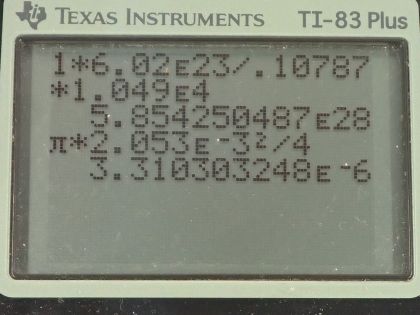Question
Repeat Example 20.3, but for a wire made of silver and given there is one free electron per silver atom.
Example 20.3 Calculate the drift velocity of electrons in a 12-gauge copper wire (which has a diameter of 2.053 mm) carrying a 20.0-A current, given that there is one free electron per copper atom. (Household wiring often contains 12-gauge copper wire, and the maximum current allowed in such wire is usually 20 A.)
Final Answer
Solution video
OpenStax College Physics for AP® Courses, Chapter 20, Problem 14 (Problems & Exercises)

vote with a rating of
votes with an average rating of
.
Calculator Screenshots
Video Transcript
This is College Physics Answers with Shaun Dychko. We are going to calculate the drift velocity of electrons through a silver wire that is 12 gauge which means it has 2.053 times 10 to the minus 3 meter diameter hence carrying 20.0 amps and we are told that there's one free electron per silver atom and we can look up the density of silver as 1.049 times 10 to the 4 kilograms per cubic meter and the atomic mass of silver which is 0.10787 grams per mole and we need these two pieces... well, these three pieces of information actually to figure out what is this density of electrons in the material and that is the spatial density so the number of electrons per cubic meter in other words. So to find the drift velocity, we rearrange this equation by dividing both sides by η, q and A and A is the cross-sectional area of the wire and we have the drift velocity then is the current divided by the electron density times the charge that's flowing, which is a single electron, and times the cross-sectional area. Of course, there are many electrons flowing but this q here represents the charge on each charge carrier that's moving and since the things that are moving are electrons then we just put the elementary charge in here, 4q. So the density of electrons we can figure out as by multiplying or dividing a whole bunch of things here such that the units work out to electrons per cubic meter. So I am gonna write down 1 electron per atom this is good because we want to have electrons in the numerator of our answer and so we already accomplished that with this factor here because we have electrons in the numerator here. We don't want these atoms in the denominator though so we'll multiply this by 6.02 times 10 to the 23 atoms per mole— this is Avogadro's number— and we are left with electrons per mole of silver and then we multiply by 1 mole for every 0.10787 kilograms so that the mole's cancel and we have electrons per kilogram at this point and then finally multiply by 1.049 times 10 to the 4 kilograms per cubic meter and we have accomplished our mission of finding electrons per cubic meter and that is 5.85425 times 10 to the 28 electrons for every cubic meter. And the cross-sectional area is the π times the radius of the wire squared but we are given the diameter so we substitute in diameter divided by 2 in place of radius and then square that and we get π times diameter squared over 4 and that's π times 2.053 times 10 to the minus 3 meters squared over 4 which is 3.3103 times 10 to the minus 6 meters squared. So now we finally return to our drift velocity formula and substitute in numbers. So we have a 20.0 amp current divided by the number of electrons per cubic meter that we calculated multiplied by the charge on each charge carrier which being an electron is 1.60 times 10 to the minus 19 coulombs multiplied by the cross-sectional area of the wire and we end up with 6.45 times 10 to the minus 4 meters per second is the drift velocity of electrons through this 12 gauge silver wire when it's carrying 20.0 amps.

